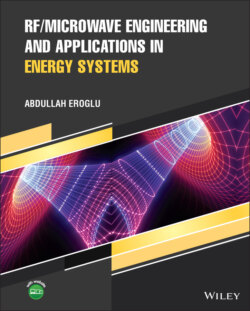Читать книгу RF/Microwave Engineering and Applications in Energy Systems - Abdullah Eroglu - Страница 48
1.4 Maxwell's Equations 1.4.1 Differential Forms of Maxwell's Equations
ОглавлениеMaxwell's equations in differential forms in the presence of an impressed magnetic current density and an electric current density can be written as [2]
(1.88)
(1.89)
(1.90)
(1.91)
where is electrical field intensity vector in volts/meter (V/m), is magnetic field intensity vector in amperes/meter (A/m), is electric current density in amperes/meter2 (A/m2), is magnetic current density in amperes/meter2 (A/m2), is magnetic flux density in webers/meter2 (W/m2), is electric flux density in coulombs/meter2 (C/m2), and ρ is electric charge density in coulombs/meter3 (C/m3).
The continuity equation is derived by taking the divergence of Eq. (1.89) and using Eq. (1.91) as
(1.92)
Since , then
(1.93)
Equation (1.93) also represents the fundamental law of physics which is known as conservation of an electric charge.
In an isotropic medium, the material properties do not depend on the direction of the field vectors. In other words, the electric field vector is in parallel with the electric flux density and the magnetic field vector is in parallel with the magnetic flux density.
(1.94)
(1.95)
ε is the permittivity of the medium and represents its electrical properties and μ is the permeability of the medium and represents its magnetic properties. They are both scalar in the existence of an isotropic medium. However, when the medium is anisotropic this is no longer the case. The electrical and magnetic properties of the medium depend on the direction of the field vectors. Electric and magnetic field vectors are not in parallel with electric and magnetic flux. So, the constitutive relations get the following forms for an anisotropic medium.
(1.96)
(1.97)
The permittivity and permeability of anisotropic medium are now tensors. They are expressed as
(1.98)
and
(1.99)
Then, (1.96) and (1.97) take the following form in a rectangular coordinate system.
(1.100)
(1.101)
(1.102)
